You, a purple mangrove crab, have had a good run. You began your life as a larva drifting around the tropical blue waters of the Indo-Pacific. When you had molted enough to settle on the seafloor, you spent your days scuttling around the chandelier-like roots of mangroves and nibbling on leaf litter. Then, one day, you found yourself scooped up into a plastic container, tied to a string, and anchored to coral rubble off the Raja Ampat islands of eastern Indonesia. There you must wait until your worst nightmare appears. It might look like a gray spaceship, one dark stripe moving across its body in the gloaming sea. It might look like a leaf, olive green and drifting slowly toward you. It might resemble an innocuous branching coral, arms kinked outward. Or, most mysteriously, it might appear as a whitish specter containing one dark, pulsing inkblot that appears and vanishes as it comes your way. But it does not much matter which of these four (sea)horsemen of your apocalypse heaves onto your horizon, because by the time they have come, it is already too late. You, precious crab, are about to become dinner.
A group of scientists have described the four distinct hunting displays of the broadclub cuttlefish in a paper recently published in the journal Ecology. They also captured video footage of each display—passing-stripe, leaf, branching coral, and pulse—from the perspective of the final moments of a crab (RIP).
The shallow seas of tropical oceans are home to many predators, each with their own tactics. Ambush predators like scorpionfish lurk in wait, passing off their bodies as something benign until it is time to strike. Others, like trumpetfish, actively pursue their prey but still rely on camouflage to conceal their approach. Cuttlefish hunt this way, camouflaging the color and texture of their body with their color-changing chromatophores and texture-altering papillae in a dizzying diversity of disguises. When cuttlefish spot a tasty fish or crustacean, they will rotate their head and body to directly face the target and triangulate its precise location. Then they will approach, and, once close enough, extend their two tentacles in a lethal strike.
But different cuttlefish approach prey differently; some species raise or wave their arms, change their colors, or display startling patterns. One 2018 paper that tested 19 cuttlefish in a lab hypothesized that these different hunting strategies are a product of the cephalopods' individual personalities. But the authors of the new paper wanted to investigate the context behind the variation in broadclub cuttlefish's hunting displays. So they tethered live crabs as bait to the reef and filmed as 98 cuttlefish—40 male and 58 female—came to hunt.
The footage revealed that the cuttlefish adopted one of the four visually distinct displays once they came within a meter or two of the crab. In leaf display, the cuttlefish held out their lateral pair of arms horizontally, changed color to a shade between olive green and white, and approached extremely slowly, like a mangrove leaf drifting in the current. In passing-stripe, the cuttlefish adopted a similar posture but took on a gray pallor with dark horizontal stripes moving down their body, which disrupted the encroaching threat of a moving, increasingly large cuttlefish. In branching coral, the cuttlefish splayed their arms in a vaguely radial pattern and took on a mottled colors to swim undetected among branching staghorn corals. And in pulse, the cuttlefish pointed two pairs of arms upward in a tight cone and took on a gray hue that pulsed slowly with a dark color. The purpose of pulse, at least to the scientists, remains unclear. But they speculate the small, dark pulse could mimic a smaller, non-threatening fish passing by.
The researchers found the cuttlefish displayed branching coral, passing-stripe, and leaf most frequently. Female cuttlefish were more likely to display leaf, but this was the only difference between the sexes. The researchers used two different species of crabs as bait: purple mangrove crabs, which are well-armored with large pinching claws, as well as mottled crabs, which are softer and have smaller claws. They found that the cuttlefish were more likely to display branching coral when hunting purple mangrove crabs.
Forty-nine cuttlefish showed up on camera more than once and performed two or more of the four total hunting displays, suggesting that the variability is not actually explained by the personalities of individual cuttlefish. (This is not to say they don't have them!) Sometimes the cuttlefish switched between displays mid-approach, beginning as branching coral and ending up as passing-stripe. And some displays even appeared to be a hybrid between two, with a cuttlefish posing as a leaf with dark pulses of color down their arms. The researchers suggest this individual variability may be more common in wild cuttlefish, which contend with more complex environments than their counterparts in the lab.
I wish I could say no animals were harmed in the making of this film, but that does not appear to be the case for the many valiant crabs who lost their lives on set. But before they died, at least they got one hell of a show.






